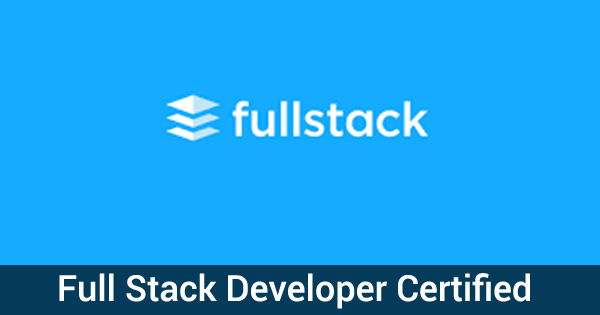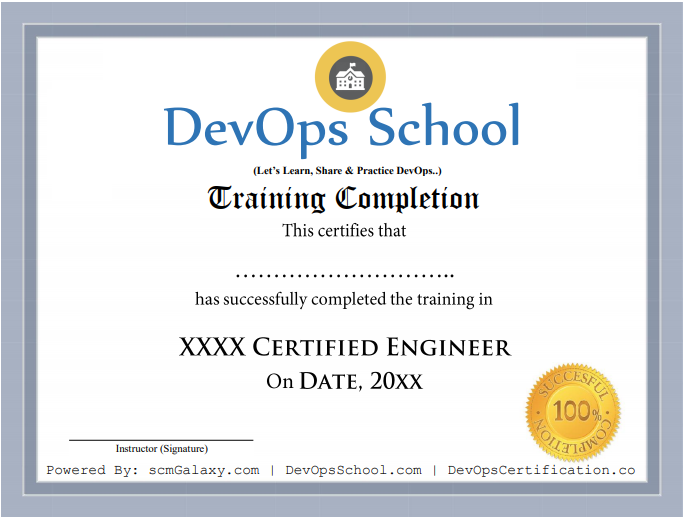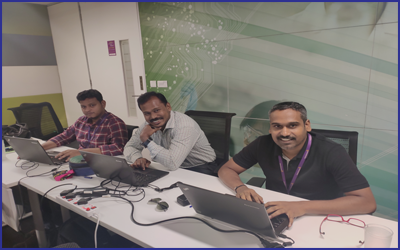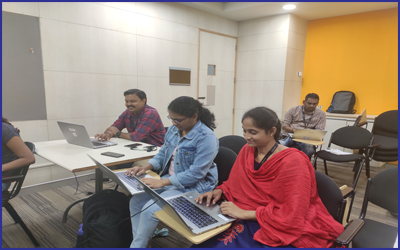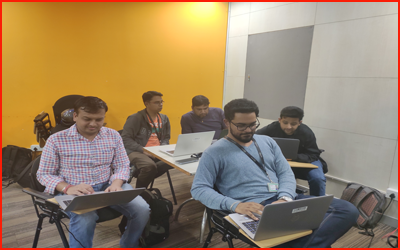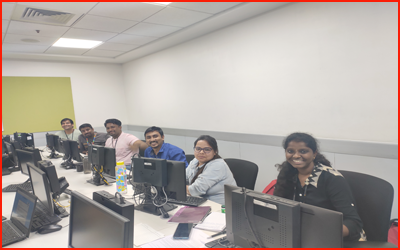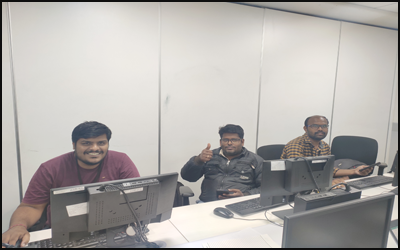Full Stack Developers Certified Professional (FSDCP)
Course Duration
63 hours
Live Project
01
Certification
Industry recognized
Training Format
8000+
Certified Learners
15+
Years Avg. faculty experience
40+
Happy Clients
4.5/5.0
Average class rating
ABOUT FULL STACK DEVELOPERS TRAINING
This Full Stack Developers course will help any programmers, developers and designers to enhance their technical skills in Agile software development methodology. One can learn the practices, principles and all the applied skills and process to integrate those methodologies that enable an agile team to succeed into daily development.
Full-stack developers are software experts with skills in front-end and back-end web development. Professionals understand most programming languages and can help you bring your minimum viable product home automatically.
Whether you are a college graduate or an experienced developer looking to upgrade yourself or an organization who wants to empower their team with the training to deliver defect-free software continuously, our course can help in the successful transition to Agile, or it can fine tune your existing implementation.
What is a full-stack developer?
When the term full-stack developer comes to mind, an employer always expects someone who has mastery over a wide range of technical solutions. A full-stack developer is a professional who understands and masters the front-end, back-end and database of web applications.
The functionality of a website or web application depends on two main elements known as front-end and backend.
What do you need to know to become a full-stack developer?
To become a full-stack developer, you need to have a proficient understanding of front-end development, back-end development and databases. A full-stack developer is a part of the development team that understands all three of these core elements of web development.
- For the front-end, you must have the skills and basic design skills such as HTML, CSS, JavaScript, etc.
- For back-end, you need to have basic knowledge of languages like Python, PHP, Ruby, etc., and work with web protocols like HTTP, SOAP, etc. and architectural style REST.
- For databases, have a proficient understanding of storage system servers such as MySQL, Oracle, etc.
INSTRUCTOR-LED, LIVE & INTERACTIVE SESSIONS
Duration |
Mode |
Agenda |
|---|---|---|
63 Hours |
Online (Instructor-led) |
Full Stack Developers |
Course Price at
24,999/-
[ Fixed - No Negotiations]
Full STACK DEVELOPERS TRAINING
Full Stack Developers
As part of this course, You would be strong in practices, principles, techniques and all techniques and tools which are required to build a good software in the iterative and incremental fashion that requires in todays software development approach.
Project
As part of this initiative, trainer would help you to execute one real time scenario based project, doing it end to end and step by step to visualize a real full stack developer work environment in any organization.
Interview
As part of this, You would given complete Full Stack Devlopers interview preparations Kit. This interview kit will help you organize your application and interview with ease.
AGENDA OF THE FULL STACK DEVELOPERS Download Curriculum
- Lets Understand about Software Development Model
- Overview of Waterfall Development Model
- Challenges of Waterfall Development Model
- Overview of Agile Development Model
- Challenges of Agile Development Model
- Requirement of New Software Development Model
- Understaning a existing Pain and Waste in Current Software Development Model
- What is DevOps?
- Transition in Software developement model
- - Waterfall -> Agile -> CI/CD -> DevOps -> DevSecOps
- Understand DevOps values and principles
- Culture and organizational considerations
- Communication and collaboration practices
- Improve your effectiveness and productivity
- DevOps Automation practices and technology considerations
- DevOps Adoption considerations in an enterprise environment
- Challenges, risks and critical success factors
- What is DevSecOps?
- Lets Understand DevSecOps Practices and Toolsets.
- What is SRE?
- Lets Understand SRE Practices and Toolsets.
- List of Tools to become Full Stack Developer/QA/SRE/DevOps/DevSecOps
Microservices Fundamentals
Microservices Patterns
- Choreographing Services
- Presentation components
- Business Logic
- Database access logic
- Application Integration
- Modelling Microservices
- Integrating multiple Microservices
What and When to test
Preparing for deployment
Monitoring Microservice Performance
Tools used for Microservices Demo using container
Keeping it simple
- Avoiding Breaking Changes
- Choosing the right protocols
- Sync & Async
- Dealing with legacy systems
- Testing
- Installing CentOS7 and Ubuntu
- Accessing Servers with SSH
- Working at the Command Line
- Reading Files
- Using the vi Text Editor
- Piping and Redirection
- Archiving Files
- Accessing Command Line Help
- Understanding File Permissions
- Accessing the Root Account
- Using Screen and Script
- Overview of Hypervisor
- Introduction of VirtualBox
- Install VirtualBox and Creating CentOS7 and Ubuntu Vms
- Understanding Vagrant
- Basic Vagrant Workflow
- Advance Vagrant Workflow
- Working with Vagrant VMs
- The Vagrantfile
- Installing Nginx
- Provisioning
- Networking
- Sharing and Versioning Web Site Files
- Vagrant Share
- Vagrant Status
- Sharing and Versioning Nginx Config Files
- Configuring Synced Folders
- Introduction of AWS
- Understanding AWS infrastructure
- Understanding AWS Free Tier
- IAM: Understanding IAM Concepts
- IAM: A Walkthrough IAM
- IAM: Demo & Lab
- Computing:EC2: Understanding EC2 Concepts
- Computing:EC2: A Walkthrough EC2
- Computing:EC2: Demo & Lab
- Storage:EBS: Understanding EBS Concepts
- Storage:EBS: A Walkthrough EBS
- Storage:EBS: Demo & Lab
- Storage:S3: Understanding S3 Concepts
- Storage:S3: A Walkthrough S3
- Storage:S3: Demo & Lab
- Storage:EFS: Understanding EFS Concepts
- Storage:EFS: A Walkthrough EFS
- Storage:EFS: Demo & Lab
- Database:RDS: Understanding RDS MySql Concepts
- Database:RDS: A Walkthrough RDS MySql
- Database:RDS: Demo & Lab
- ELB: Elastic Load Balancer Concepts
- ELB: Elastic Load Balancer Implementation
- ELB: Elastic Load Balancer: Demo & Lab
- Networking:VPC: Understanding VPC Concepts
- Networking:VPC: Understanding VPC components
- Networking:VPC: Demo & Lab
- What is Virtualization?
- What is Containerization?
- Why Containerization?
- How Docker is good fit for Containerization?
- How Docker works?
- Docker Architecture
- Docker Installations & Configurations
- Docker Components
- Docker Engine
- Docker Image
- Docker Containers
- Docker Registry
- Docker Basic Workflow
- Managing Docker Containers
- Creating our First Image
- Understading Docker Images
- Creating Images using Dockerfile
- Managing Docker Images
- Using Docker Hub registry
- Docker Networking
- Docker Volumes
- Deepdive into Docker Images
- Deepdive into Dockerfile
- Deepdive into Docker Containers
- Deepdive into Docker Networks
- Deepdive into Docker Volumes
- Deepdive into Docker Volume
- Deepdive into Docker CPU and RAM allocations
- Deepdive into Docker Config
- Docker Compose Overview
- Install & Configure Compose
- Understanding Docker Compose Workflow
- Understanding Docker Compose Services
- Writing Docker Compose Yaml file
- Using Docker Compose Commands
- Docker Compose with Java Stake
- Docker Compose with Rails Stake
- Docker Compose with PHP Stake
- Docker Compose with Nodejs Stake
- Overview of Jira
- Use cases of Jira
- Architecture of Jira
- Installation and Configuraration of Jira in Linux
- Installation and Configuraration of Jira in Windows
- Jira Terminologies
- Understanding Types of Jira Projects
- Working with Projects
- Working with Jira Issues
- Adding Project Components and Versions
- Use Subtasks to Better Manage and Structure Your Issues
- Link Issues to Other Resources
- Working in an Agile project
- Working with Issues Types by Adding/Editing/Deleting
- Working with Custom Fields by Adding/Editing/Deleting
- Working with Screens by Adding/Editing/Deleting
- Searching and Filtering Issues
- Working with Workflow basic
- Introduction of Jira Plugins and Addons.
- Jira Integration with Github
- Exploring Confluence benefits and resources
- Configuring Confluence
- Navigating the dashboard, spaces, and pages
- Creating users and groups
- Creating pages from templates and blueprints
- Importing, updating, and removing content
- Giving content feedback
- Watching pages, spaces, and blogs
- Managing tasks and notifications
- Backing up and restoring a site
- - Add/Edit/Delete new users
- - Adding group and setting permissions
- - Managing user permissions
- - Managing addons or plugins
- - Customizing confluence site
- - Evaluation options for Confluence
- - Supported platforms
- - Installing Confluence on Windows
- - Activating Confluence trial license
- - Finalizing Confluence Installation
- Introduction
- Setup Java Development Environment
- Java Language Fundamental
- Arrays and Loops
- Java Methods
- Conditioning and Looping in Java
- Exception Handling
- Basics of Oops in Java
- Create a Java Package using Jar
- Creating Basic Java Web Based application
- Create a Java Package using War
- Deploy Web App in Tomcat Environment
- Interpreted languages
- Advantages and disadvantages
- Downloading and installing
- Which version of Python
- Where to find documentation
- Running Python Scripts
- String types: normal, raw and Unicode
- String operators and expressions
- Math operators and expressions
- Writing to the screen
- Command line parameters
- Reading from the keyboard
- Flow Control
- Using the interpreter interactively
- Running standalone scripts under Unix and Windows
- Getting Started
- Indenting is significant
- The if and elif statements
- while loops
- Using lists
- Using the for statement
- The range() function
- Sequence Data
- list methods
- Strings are special kinds of lists
- tuples
- sets
- Dictionaries
- Defining Functions
- Opening a text file
- Reading text files
- Raw (binary) data
- Using the pickle module
- Writing to a text file
- Dictionaries and Sets
- Formal parameters
- Global versus local variables
- Passing parameters and returning values
- Working with Files
- Creating dictionaries
- Creating dictionaries
- Fetching keys or values
- Testing for existence of elements
- Deleting elements
- Errors and Exception Handling
- What is HTML
- WHY HTML
- HTML Anatomy
- Intro To Brackets
- Introduction
- HTML First Page
- Body and self closing tags
- Headings
- Paragraph And Span
- HTML Formating
- images
- Brackets Extensions
- Tables
- div
- What is CSS?
- Why CSS?
- CSS Syntax And Element Selectors
- Class Selector
- ID Selector
- More About Selectors
- Chaining Selectors
- JavaScript
- Getting Started
- JavaScript Basics
- JavaScript Operators
- JavaScript ControlFlow
- JavaScript Objects
- JavaScript Arrays
- JavaScript Functions
- Getting Started
- JavaScript Basics
- JavaScript Operators
- JavaScript ControlFlow
- JavaScript Objects
- JavaScript Arrays
- JavaScript Functions
Project - Website Design using HTML, CSS and JS.
- Understanding version control
- The history of Git
- About distributed version control
- Who should use Git?
- Installing Git on a Mac
- Installing Git on Windows
- Installing Git on Linux
- Configuring Git
- Exploring Git auto-completion
- Using Git help
- Initializing a repository
- Understanding where Git files are stored
- Performing your first commit
- Writing commit messages
- Viewing the commit log
- Exploring the three-trees architecture
- The Git workflow
- Using hash values (SHA-1)
- Working with the HEAD pointer
- Adding files
- Editing files
- Viewing changes with diff
- Viewing only staged changes
- Deleting files
- Moving and renaming files
- Using Git with a Real Project
- Introducing the Explore California web site
- Initializing Git
- Editing the support phone number
- Editing the backpack file name and links
- Undoing working directory changes
- Unstaging files
- Amending commits
- Retrieving old versions
- Reverting a commit
- Using reset to undo commits
- Demonstrating a soft reset
- Demonstrating a mixed reset
- Demonstrating a hard reset
- Removing untracked files
- Using .gitignore files
- Understanding what to ignore
- Ignoring files globally
- Ignoring tracked files
- Tracking empty directories
- Referencing commits
- Exploring tree listings
- Getting more from the commit log
- Viewing commits
- Comparing commits
- Branching overview
- Viewing and creating branches
- Switching branches
- Creating and switching branches
- Switching branches with uncommitted changes
- Comparing branches
- Renaming branches
- Deleting branches
- Configuring the command prompt to show the branch
- Merging code
- Using fast-forward merge vs. true merge
- Merging conflicts
- Resolving merge conflicts
- Exploring strategies to reduce merge conflicts
- Fast Forward Merge
- Three way Merge
- Rebasing
- Saving changes in the stash
- Viewing stashed changes
- Retrieving stashed changes
- Deleting stashed changes
- Using local and remote repositories
- Adding a remote repository
- Creating a remote branch
- Cloning a remote repository
- Tracking remote branches
- Pushing changes to a remote repository
- Fetching changes from a remote repository
- Merging in fetched changes
- Checking out remote branches
- Pushing to an updated remote branch
- Deleting a remote branch
- Enabling collaboration
- A collaboration workflow
- Setting up aliases for common commands
- Using SSH keys for remote login
- Exploring integrated development environments
- Exploring graphical user interfaces
- Understanding Git hosting
- Conclusion
- Lightweight tags
- Annotated tags
- Signed Tags
- Create tags in Git
- Create tags in Stash
- Checkout tags in Git
- How to view tags
- How to checkout tags
- Installing SonarQube
- Analyzing Source Code
- UI Tips
- Browsing a Project
- Issues
- Measures
- Plugin Library
- Local and Branch Analysis
- Web Services API
- Coding new Rules
- API Basics
- Internationalization
- Learning MySQL 8
- Getting to Know the MySQL 8 Architecture
- Installation via Package Manager
- Installation via Manual Package
- Upgrading an Existing Database to MySQL 8
- Using Tools to Access the Database
- Getting to Know Your Database
- Changing Configuration Parameters in my.cnfChanging MySQL Configuration Parameters Online
- Essential MySQL Configuration Parameters
- Accessing the Data Dictionary
- Essential InnoDB
- Creating Databases and Users for Applications
- Managing Users
- Performing Basic Troubleshooting
- Learning SQL: Querying Data
- Learning SQL: Inserting and Modifying Data
- Learning SQL: Design Databasest
- What is Gradle?
- Why Gradle?
- Installing and Configuring Gradle
- Build Java Project with Gradle
- Build C++ Project with Gradle
- Build Python Project with Gradle
- Dependency Management in Gradle
- Project Structure in Gradle
- Gradle Tasks
- Gradle Profile and Cloud
- Gradle Properties
- Gradle Plugins
Artifactory
- Artifactory Overview
- Understanding a role of Artifactory in DevOps
- System Requirements
- Installing Artifactory in Linux
- Using Artifactory
- Getting Started
- General Information
- Artifactory Terminology
- Artifactory Repository Types
- Artifactory Authentication
- Deploying Artifacts using Maven
- Download Artifacts using Maven
- Browsing Artifactory
- Viewing Packages
- Searching for Artifacts
- Manipulating Artifacts
Packer
- What is Packer?
- Save What is Packer?
- Installing Packer
- Save Installing Packer
- The Packer workflow and components
- Save The Packer workflow and components
- The Packer CLI
- Save The Packer CLI
- Select an AWS AMI base
- Save Select an AWS AMI base
- Automate AWS AMI base build
- Save Automate AWS AMI base build
- Using build variables
- Save Using build variables
- Provision Hello World
- Save Provision Hello World
- Provision a basic site
- Save Provision a basic site
- Simplify provisioning with a config tool
- Save Simplify provisioning with a config tool
- Use ansible to install the webserver
- Save Use ansible to install the webserver
- Debugging
- Save Debugging
- Use Ansible modules to harden our image
- Save Use Ansible modules to harden our image
- Baking a Jenkins image
- Save Baking a Jenkins image
- Validate Packer templates
- Save Validate Packer templates
- Create a manifest profile
- Save Create a manifest profile
- Testing
- Save Testing
- CI pipeline
- Save CI pipeline
- Bootstrap Overview
- Bootstrap Environment Setup
- Bootstrap Grid System
- Bootstrap CSS Overview
- Bootstrap Typography
- Bootstrap Code
- Bootstrap Tables
- Bootstrap Forms
- Bootstrap Buttons
- Bootstrap Images
- Bootstrap Helper Classes
- Bootstrap Responsive utilities
- Bootstrap Thumbnails
- Bootstrap Alerts
- Bootstrap Progress Bars
- Bootstrap Media Object
- Bootstrap List Group
- Bootstrap Panels
- Bootstrap Wells
- Bootstrap Tab Plugin
- Bootstrap Tooltip Plugin
- Bootstrap Popover Plugin
- Bootstrap Alert Plugin
- Bootstrap Button Plugin
- Bootstrap Collapse Plugin
- Bootstrap Carousel Plugin
- Introduction to jQuery
- Why use jQuery?
- Getting Started with jQuery
- Using Content Delivery Networks
- Using the jQuery ready() Function
- Getting to Know the jQuery Documentation
- Using jQuery Selectors
- Interacting with DOM
- jQuery Handling Events
- Working with Ajax features
- Introduction
- About NGINX
- NGINX vs Apache
- Test your knowledge
- Server Overview
- Installing with a Package Manager
- Building Nginx from Source & Adding Modules
- Adding an NGINX Service
- Nginx for Windows
- Test your knowledge
- Headers & Expires
- Compressed Responses with gzip
- FastCGI Cache
- HTTP2
- Server Push
- HTTPS (SSL)
- Rate Limiting
- Basic Auth
- Hardening Nginx
- Test your knowledge
- Let's Encrypt - SSL Certificates
- Understanding Configuration Terms
- Creating a Virtual Host
- Location blocks
- Variables
- Rewrites & Redirects
- Try Files & Named Locations
- Logging
- Inheritance & Directive types
- PHP Processing
- Worker Processes
- Buffers & Timeouts
- Adding Dynamic Modules
- Test your knowledge
- What Is Spring?
- Architecture and Project Setup
- Spring Configuration Using Java
- Spring Scopes and Autowiring
- Spring Configuration Using XML
- Advanced Bean Configuration
Junit Fundamental
- What is Unit Testing
- Tools for Unit Testing
- What is Junit?
- How to configure Junit?
- Writing Basic Junit Test cases
- Running Basic Junit Test cases
- Junit Test Results
PyTest Fundamental
- What is PyTest?
- How to configure PyTest?
- Writing Basic PyTest Test cases
- Running Basic PyTest Test cases
- PyTest Test Results
- What is Continuous Integration
- Benefits of Continuous Integration
- What is Continuous Delivery
- What is Continuous Deployment
- Continuous Integration Tools
- Jenkins Vs TeamCity Vs Bamboo
- History of Jenkins
- Release of Jenkins
- Jenkins Vs Jenkins Enterprise
- Prerequisites
- Installing Jenkins using Yum
- Installing Jenkins using Apt
- Installing Jenkins using MSI
- Installing Jenkins using Tomcat
- Installing as a Service
- Starting and Stopping Jenkins
- Understand Freestyle Project
- Freestyle General Tab
- Freestyle Source Code Management Tab
- Freestyle Build Triggers Tab
- Freestyle Build Environment
- Freestyle Build
- Freestyle Post-build Actions
- Manage Jenkins
- My Views
- Credentials
- People
- Build History
- Simple Java and Maven Based Application
- Simple Java and Ant Based Application
- Simple Java and Grovy Based Application
- Simple DOTNET and MSBuild Based Application
- Simple C++ using Batch Application
- Manually Building
- Build Trigger based on fixed schedule
- Build Trigger by script
- Build Trigger Based on pushed to git
- Jenkins Jobs parameterised
- Execute concurrent builds
- Jobs Executors
- Build Other Projects
- Build after other projects are built
- Throttle Builds
- Installing a Plugin
- Plugin Configuration
- Updating a Plugin
- Plugin Wiki
- Top 20 Useful Jenkins Plugins
- Using Jenkins Pluginss Best Practices
- Adding a Linux Node
- Adding a Windows Nodes
- Nodes Management using Jenkins
- Jenkins Nodes High Availability
- Jira
- Git
- SonarQube
- Maven
- Junit
- Chef
- Puppet
- Ansible
- Docker
- AWS
- Jacoco
- Coverity
- Selenium
- Gradle
- Terraform
- Packer
- Junit Report
- SonarQube Reports
- Jacoco Reports
- Coverity Reports
- Selenium Reports
- Test Results
- Cucumber Reports
- Adding a Linux Node
- Adding a Windows Nodes
- Nodes Management using Jenkins
- Jenkins Nodes High Availability
- CI Build Pipeline & Dashboard
- Email Notification
- Advance Email Notification
- Slack Notification
- Security in Jenkins
- Authorization in Jenkins
- Authentication in Jenkins
- Managing folder/subfolder
- Jenkins Upgrade
- Jenkins Backup
- Jenkins Restore
- Jenkins Command Line
PROJECT
As part of this initiative, trainer would help you to execute one real time scenario based project, doing it end to end and step by step to visualize a real Agile work environment in any organization.
INTERVIEW
As part of this, You would given complete Agile Devlopers interview preparations Kit. This interview kit will help you organize your application and interview with ease.
OUR COURSE IN COMPARISON
| FEATURES | DEVOPSSCHOOL | OTHERS |
|---|---|---|
| Lifetime Technical Support | ||
| Lifetime LMS access | ||
| Top 21 Tools | ||
| Real time scenario projects | ||
| Mock Interviews after Training | ||
| Step by Step Web Based Tutorials | ||
| Training Slides |
Full-stack web developer helps you keep every part of the system running smoothly. Full stack developer skills are required to work with front-end technologies, development languages, databases, basic design ability, servers, APIs and version control systems.
The Role of Developers in the current work culture has been evolved broadly and now developers have aditional responsibilities that more than simply writing code.
No one wants to release software with lots of performance issues, bugs and low customer satisfacation. Continuous integration and continuous code review can prevent with all those issues. But who will do that? Answer is Agile team.
Agile is a mindset empowered by the values and principles behind the Agile Manifesto. In Agile software development process, there is a big focus on collaboration and the self-organizing cross-functional team. And there Full Stack Developers focus on sustainable development which embrace good estimation, effective branching strategies for managing code, automated testing to protect quality, and continuous deployment to get fast feedback from the end users.
Being a Developer in agile team, you will have start to think differently. Instead of defining role and department, you will have to target and focus on the customer's requirement. Members of the development team are expected to be multi-tasking and multi-skilled professionals so that their skills can be used for project implementation.
As a Developer, learning agile methodolgies will be the best professional decision you can ever make. Adding Agile infront of the Devlopers role will put you in the pilot's seat for the highest paid IT positions. Agile implementation has been adopted by approximately all companies globally and just be a Developer in the current industry is not enough.
- Our course would enhance your full stack software delivery skills
- Our course will help you to learn all the tools and skills to effectively build amd release features in sprints
- Help you to learn code refactoring, diagnose and fix poor code paths
- Our curriculum contains professional skills training and validation as well as industry recognized qualifications.
- DevOpsSchool offers accredited certification from DevOpsCertification.co which is one of the recognized and well-regarded organization in the training and development domain.
- Our Agile Developer course would be delivered by top industry experts
Full stack developer skills are required to work with front-end technologies, development languages, databases, basic design ability, servers, APIs and version control systems. A Java full-stack developer can build a complete Java application, including front-end, back-end, database, API, server, and version control.
- Bachelor's Degree in Computer Science.
- Fluent in CSS (Foundation or Bootstrap), JavaScript and HTML, with an understanding of CSS preprocessors including Sass and LESS.
